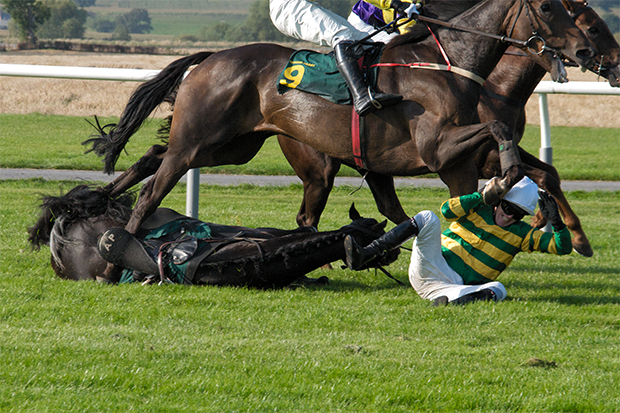Peta Hitchens
Swedish University of Agricultural Sciences
 It is one year since the tragic deaths of jockeys Carly-Mae Pye and Caitlin Forrest in Australia. Since then, horse racing has claimed two more lives – track work riders English-born Lizz Rice and German-born Friederike Ruhle.
It is one year since the tragic deaths of jockeys Carly-Mae Pye and Caitlin Forrest in Australia. Since then, horse racing has claimed two more lives – track work riders English-born Lizz Rice and German-born Friederike Ruhle.
When it comes to safety, a lack of initiative or leadership from high ranking regulators and administrators seems to be the common thread.
The racing industry remains reactive to the deaths, and catastrophic or career-ending injuries suffered by both jockeys and racehorses. It is an inevitable part of racing they say.
These are the same justifications a decade on since the deaths that both occurred over a long-weekend in 2005, that of Gavin Lisk and Adrian Ledger. Their deaths prompted a safety review, but what evidence-based solutions has the industry implemented since recommendations were released to address these safety concerns?
Following the deaths last year, research commissioned by the Chief Executive Officer of the newly formed Racing Australia, Peter McGauran, shows that 16 of the last 22 jockeys killed in Australian racing died from massive head injuries.
But the report from this research has not yet been released to the public, and has not undergone peer-review (like several of the commissioned reports by the ARB).
Where is the transparency and control of bias that could result from an industry commissioned study? Where are the insights that tell us something that we did not already know? Why are there not public reports issued by the regulators?
Recent studies
Previous studies in Australia have described the incidence of falls, injuries and fatalities and risk factors, and studies on the effectiveness of jockey helmets and safety vests. But up until recently, there had been no comprehensive study of the costs of horse-related workplace injuries to jockeys in Australia.

Part of a research programme into insurance costs of jockeys, funded by WorkCover Tasmania and led by Professor Andrew Palmer and myself, one study published last month was based on data from all WorkCover authorities nation-wide. We found that the incidence of insurance claims between 2002 and 2010 was about 2 per 1,000 race rides, costing A$9-million a year.
With about 180,000 race rides a year, this translates to almost one claim per day.
Although race-day incidents were associated with fewer insurance claims than non-race day incidents, they made up a larger proportion of the total costs, reflecting the severity of incidents that occur during races.
Fractures were the most common injury (30%), but head injuries resulting from a fall from a horse had the highest mean cost per claim. This data has also been combined with incidence and risk factor data from previous studies to demonstrate that the incidence and costs of jockey falls and injuries can be significantly reduced through the implementation of policies aimed at improving safety.
But there is little evidence of action on such evidence-based policies.
Racing’s social licence
The success of racing is highly dependent on the public’s perception of the industry. Major threats to the industry include the adverse publicity resulting from the deaths of jockeys and racehorses, particularly those that are high-profile.
The industry needs to meet (and preferably exceed) the community and other stakeholders level of approval. There needs to be a focus on programs that transparently lead to a better understanding of strategies that improve racehorse welfare and rider safety, which in turn leads to policy changes that will enhance the confidence of the community in the industry.
If the racing industry wants to keep its support, it needs to bring its safety strategies into the current century. The simple fact is that racing can’t improve what it doesn’t measure. But safety in racing can be measured and benchmarked. It is the only way to confirm which safety strategies and practices are working.
Horse racing is, after all, about big business, big money and big data. The latter because of the vast amounts of data generated for use by the betting public to predict race winners.
I feel like a broken record here when I say that stewards’ inquiries into individual incidents are unlikely to result in findings that are useful.
Regulators should be using the industry’s aptitude at data collation and analysis to detect patterns and to monitor the effects of rule, policy and practice changes in order to improve safety and welfare to both jockeys and racehorses alike.
This model has been successfully demonstrated overseas, for example, by the California Horse Racing Board (CHRB), which publishes its report on racehorse deaths and results of post-mortems annually.
Over the past five years the CHRB has seen a 30% reduction in the number of racehorse fatalities. Further, the number of fatalities in 2013/14 was the lowest number of fatalities of the past 19 years. This reduction has been attributed, in part, to a targeted racing safety program.
Racing in Australia needs leaders that understand that data collection and analysis can lead to faster uptake of evidence-based safety strategies and that this information needs to be widely disseminated. Only then will the culture change.
Copyright © Peta Hitchens 2015
This article was originally published on The Conversation.
Read the original article.


